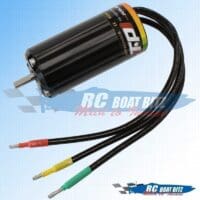Choosing a Brushless Motor for FE (fast electric) RC Boats
With all the available brushless motor options on the market today it can be a daunting task to choose the most appropriate one for your rc boat build.
Choosing the wrong motor will most likely be a costly exercise, of which I have extensive personal experience! My brushless boat journey began in the 90s when nitros (glow motors) were king, and electrics were considered toys. The few websites selling brushless rc boat motors at the time had little knowledge of their products and offered no technical assistance, plus hull options were mainly heavy nitro hulls. All this factored together ended up with many boxes of smoked speed controls and puffed lipo batteries.
Hopefully, this article will be able to help you avoid the mistakes that I made when I first got into hobby parts, This article will teach you everything you need to know about choosing a motor for your next rc build
Choosing The Correct Motor Diameter
You want to start with the correct can size (motor diameter) to suit the size and weight of the hull you intend to run.
Here are some basic starting point suggestions for a single motor hull
- 28-29mm can size- will power most hulls up to 600mm
- 36mm can size- up to around 800mm
- 40mm can size- up to 1200mm as long as it’s a light brushless dedicated or abs hull
- Anything over that will require 56 – 58mm motor
Obviously there will be crossover sizes and out of the norm setups. For instance I fitted a TP 58mm TP Pro Comp 5850 V1 7D 1010kv motor to an 800mm TFL pursuit once and it performed very well indeed.
Rc Boat Bitz offers a wide range of brushless dc motors to suit all different sizes of boats and other hobbies. Take a look at the wide range of motors and other accessories we have in stock. Worldwide Shipping
Shop RC Boat MotorsUnderstanding Motor KV Ratings
Once you’ve chosen the correct can size you need to look at KV. This is where most people can get stuck.
KV means RPM per volt, or the amount of times your motor will complete a full revolution per volt of power. Simply put you multiply your KV by battery voltage.
A 6s lipo battery has 6 cells, each being 4.2v when fully charged. Under load the voltage will be more like 3.9v per cell, so that is a good number to estimate RPM.
A lot of people will look at motor spec charts and see a motor like this one TP Pro Comp 4060 V1 7D 1380KV has a max RPM of 50K and assume that’s what you should aim for, but it’s just that – the maximum RPM the motor can spin to, it’s not the maximum operating RPM.
The larger the can size the lower the safe operating rpm will be. As a very rough guide for maximum SAFE working RPMs here are some examples.
- 36mm can size 40,000 – 45,000 rpm
- 40mm can size 35,000-40,000 rpm
- 58mm can size 28,000 – 30,000 rpm.
- For example a proven and reliable 40mm motor for a 6s Traxxas Spartan is a TP Pro Comp 4060 V1 6D 1650KV
Maximum loaded voltage being 3.9v per cell, so 3.9 x 6 = 23.4v
23.4 x 1650kv = 38,610rpm.
Things like hull design and weight, battery specs and prop size/pitch will all cause variations, so if you are torn between 2 motor KV’s the safest way is to choose the lower one, you can always run a larger prop to account for less RPM.
It also depends on what you want out of your boat. Do you want long run times without stressing out your batteries, or are you looking for a ‘youtube special’ capable of one or 2 passes at the risk of puffed batteries or a seized motor after each run?
After choosing your kv you then build around that by finding the most appropriate esc and prop. Those are separate topics of equal importance.
– Joe Dimech
Owner RC Boat Bitz
The suggestions in this article are simply that, based on my experiences over the past 25 years in this wonderful hobby



Think you good shi*
Good info for beginner.
It seems to me that there is, at least, one missing variable in this calculation: Prop pitch. Somewhere along the way, prop pitch will help determine the correct RPM for a given boat. 50,000 RPM on an RC Ocean Liner motor? I don’t think so…
So, how do you factor that into motor sizing?